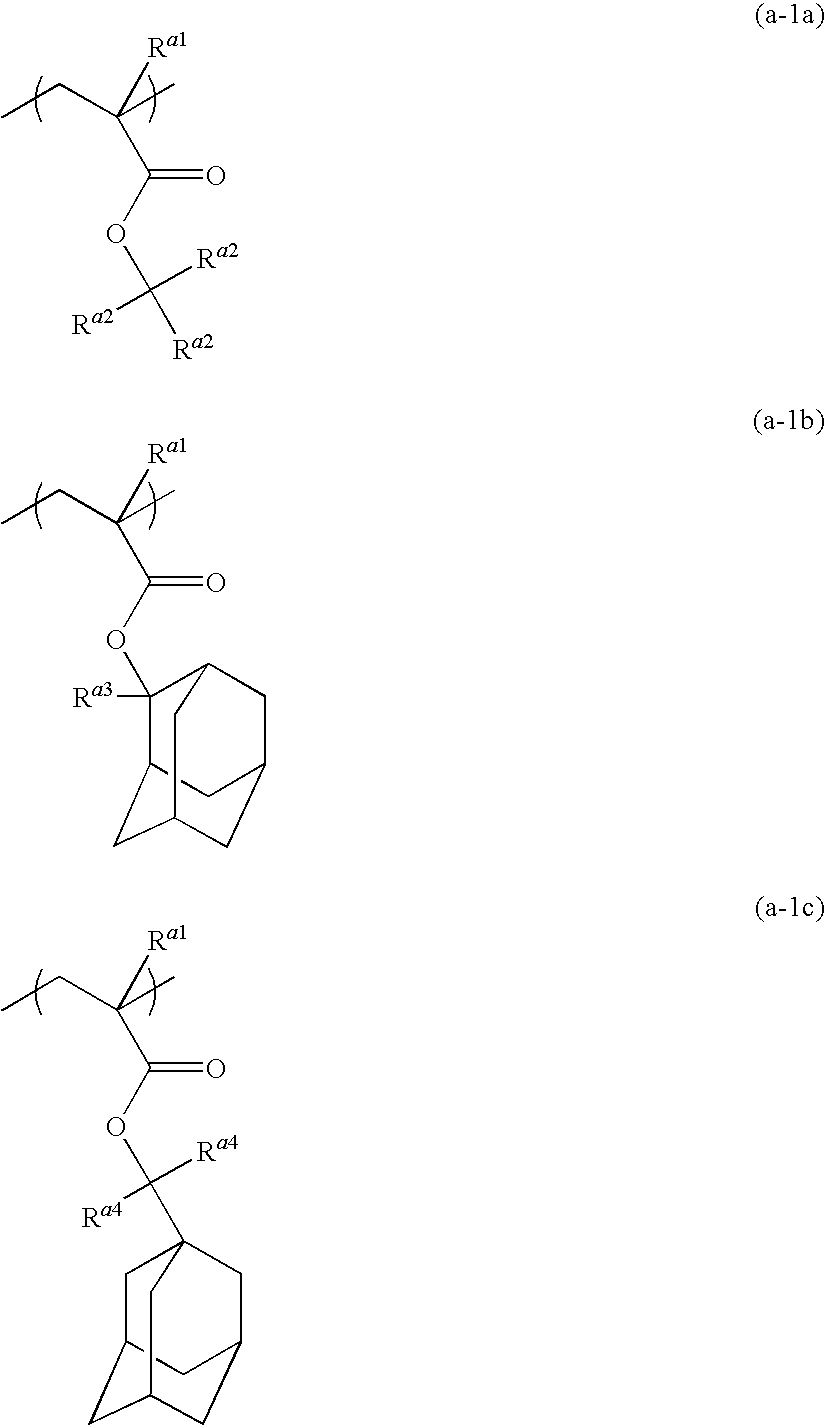Radiation-sensitive resin composition
a technology of radiofrequency and resin, applied in the direction of photosensitive materials, photomechanical equipment, instruments, etc., can solve the problems of compound remaining undecomposed in the environment, and the inability to achieve the desired performance of such a method
- Summary
- Abstract
- Description
- Claims
- Application Information
AI Technical Summary
Benefits of technology
Problems solved by technology
Method used
Image
Examples
synthesis example 1
Resin (A-1)
[0178]A monomer solution was prepared by dissolving 9.42 g (25 mol %) of the monomer (M-1), 11.14 g (25 mol %) of the monomer (M-2), and 29.44 g (50 mol %) of the monomer (M-7) in 100 g of 2-butanone, and adding 2.175 g of dimethyl 2,2′-azobis(2-methylpropionate) to the solution.
[0179]A 500 ml three-necked flask equipped with a thermometer and a dropping funnel was charged with 50 g of 2-butanone, and purged with nitrogen for 30 minutes. The inside of the flask was then heated to 80° C. with stirring using a magnetic stirrer. The monomer solution was added dropwise to the flask using the dropping funnel over three hours. The monomers were polymerized for six hours from the start of the addition of the monomer solution. After completion of polymerization, the polymer solution was cooled with water to 30° C. or less. The polymer solution was then added to 1000 g of methanol, and a precipitated white powder was collected by filtration. The white powder was washed twice with ...
synthesis examples 2 to 6
Resins (A-2) to (A-6)
[0181]Resins (A-2) to (A-6) were synthesized in the same manner as in Synthesis Example 1, except for changing the composition as shown in Table 1.
[0182]The measurement results for the ratio (mol %) of the repeating units determined by 13C-NMR analysis, yield (%), Mw, and dispersity (Mw / Mn) of the resins (A-2) to (A-6) are shown in Table 1.
(Preparation of Radiation-Sensitive Resin Compositions)
[0183]Tables 2-1 and 2-2 show the composition of the radiation-sensitive resin composition prepared in each example and comparative example. The components (acid generator (B), acid diffusion controller (C), and solvent (D)) of the radiation-sensitive composition other than the resins (A-1) to (A-5) synthesized in the synthesis examples are given below.
[0184](B-1): Triphenylsulfonium 2-(adamantane-1-carbonyloxy)-1,1-difluoroethanesulfonate
[0185](B-2): 1-(4-n-Butoxynaphthalen-1-yl)tetrahydrothiophenium 2-(adamantane-1-carbonyloxy)-1,1-difluoroethanesulfonate
[0186](B-3): 4-C...
example 1
[0205]100 parts by mass of the resin (A-1) obtained in Synthesis Example 1, 8.6 parts by mass of triphenylsulfonium 2-(adamantane-1-carbonyloxy)-1,1-difluoroethanesulfonate (B-1) (acid generator (B)), and 0.7 parts by mass of N-t-butoxycarbonyl-4-hydroxypiperidine (C-1) (acid diffusion controller (C)) were mixed. 1500 parts by mass of propylene glycol monomethyl ether acetate (D-1) and 650 parts by mass of cyclohexanone (D-2) (solvent (D)) were added to the mixture to obtain a mixed solution. The resulting mixed solution was filtered through a filter with a pore size of 0.20 μm to obtain a radiation-sensitive resin composition. Tables 2-1 and 2-2 show the composition of the radiation-sensitive resin composition.
PUM
| Property | Measurement | Unit |
|---|---|---|
| width | aaaaa | aaaaa |
| mass % | aaaaa | aaaaa |
| temperature | aaaaa | aaaaa |
Abstract
Description
Claims
Application Information
 Login to View More
Login to View More - R&D
- Intellectual Property
- Life Sciences
- Materials
- Tech Scout
- Unparalleled Data Quality
- Higher Quality Content
- 60% Fewer Hallucinations
Browse by: Latest US Patents, China's latest patents, Technical Efficacy Thesaurus, Application Domain, Technology Topic, Popular Technical Reports.
© 2025 PatSnap. All rights reserved.Legal|Privacy policy|Modern Slavery Act Transparency Statement|Sitemap|About US| Contact US: help@patsnap.com



